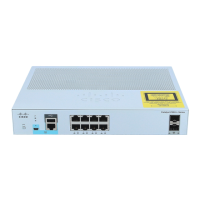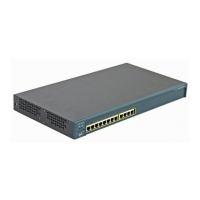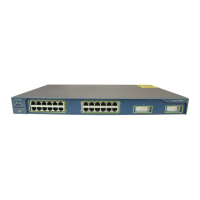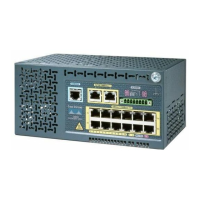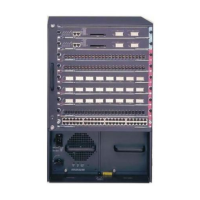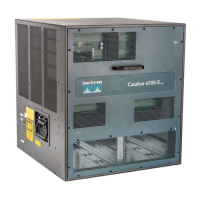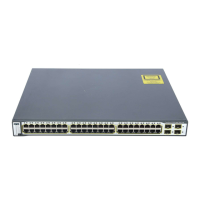
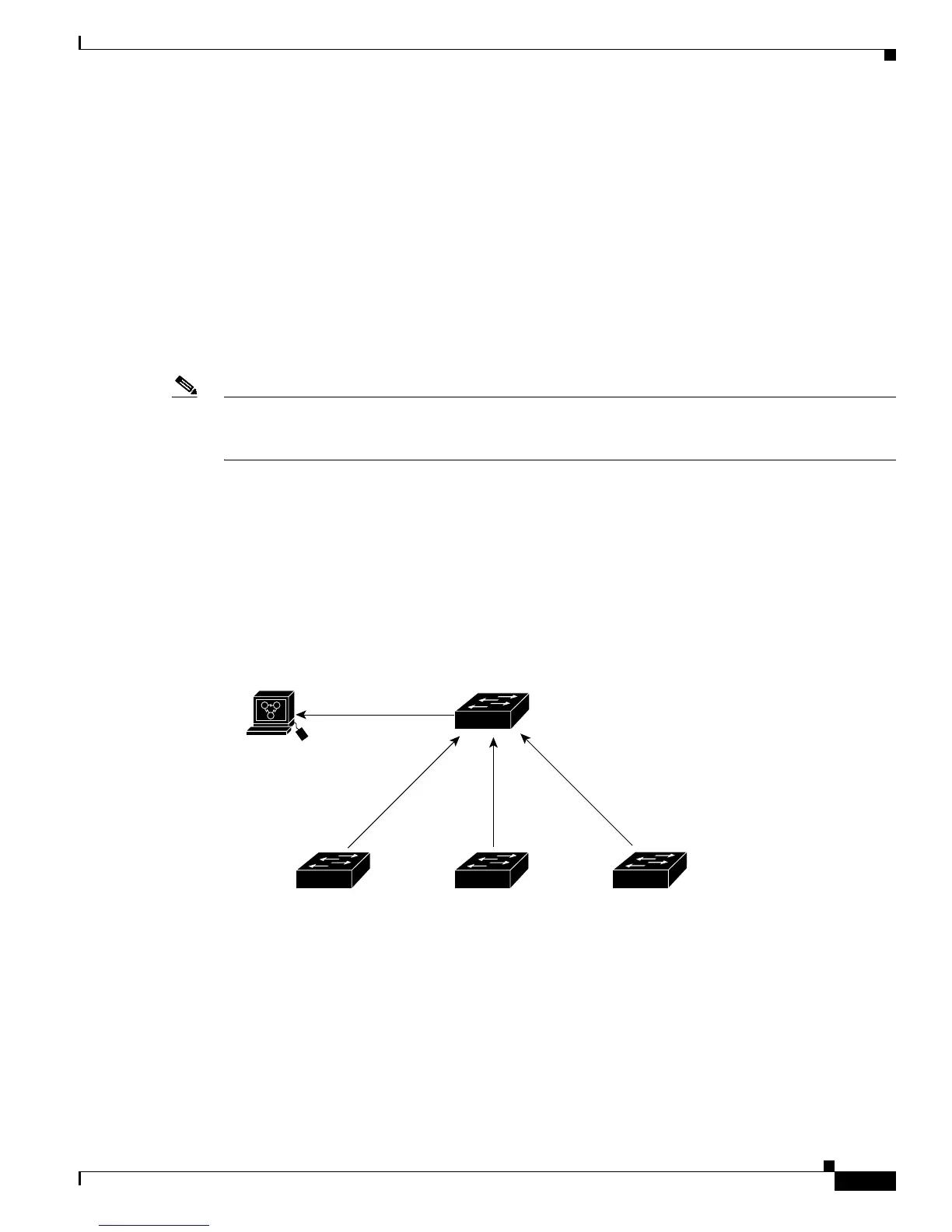
Do you have a question about the Cisco WS-C2960-24TT-L and is the answer not in the manual?
| Model | WS-C2960-24TT-L |
|---|---|
| Forwarding Rate | 6.5 Mpps |
| RAM | 64 MB |
| Flash Memory | 32 MB |
| Power Device | Internal power supply |
| Form Factor | Rack-mountable |
| Weight | 3.6 kg |
| Product Series | Cisco Catalyst 2960 |
| Uplink Ports | 2 x 10/100/1000 |
| MAC Address Table Size | 8000 entries |
| Routing Protocol | Static IP routing |
| Features | VLAN support, Quality of Service (QoS) |
| Compliant Standards | IEEE 802.3, IEEE 802.1D, IEEE 802.1Q, IEEE 802.1p |
| Status Indicators | system status |
| Voltage Required | 100-240 VAC |
| Dimensions (H x W x D) | 4.4 cm x 45 cm x 23.6 cm |
| Operating Temperature | 0 to 40 °C |
| Operating Humidity | 10% to 85% non-condensing |
| Power Consumption | 30 W |
| Ports | 24 10/100 Ethernet ports |
Describes the software features for Catalyst 2900 XL and Catalyst 3500 XL switches.
Discusses the various interfaces for configuring and monitoring switches and clusters.
Provides examples of using switches to create dedicated network segments.
Guides users to related sections for further startup information.
Details the features of the Cluster Management Suite (CMS) for managing switches.
Explains the Front Panel view in CMS for displaying switch images and selecting ports.
Describes the Topology view for displaying network maps and device connections.
Explains how to use menus and toolbars in CMS for configuration and management.
Describes the Guide and Expert modes for configuring features in CMS.
Explains how wizards simplify configuration tasks by requiring minimal information.
Details the comprehensive online help available within CMS for assistance.
Describes the components of a typical CMS window, like tabs, lists, and buttons.
Provides steps for accessing the CMS interface through a web browser.
Explains how CMS provides notification cues to track and confirm changes.
Details how to save configuration changes to Flash memory to prevent loss on restart.
Discusses how CMS can differ between IOS releases and switch platforms.
Guides users to relevant sections for further information on CMS and clusters.
Covers topics like accessing command modes, abbreviating commands, and getting help.
Lists common CLI error messages and how to get help for them.
Explains how to access the CLI through a terminal session or a web browser.
Details how to save running configuration changes to startup configuration.
Guides users to related sections for further startup information.
Covers tasks like cabling, using the setup program, and assigning IP information.
Discusses how to check software versions and the importance of upgrades.
Explains how to access the switch through the console port.
Provides steps for accessing the CLI via Telnet for switch management.
Details how to access the CMS interface using HTTP.
Discusses using SNMP-compatible management stations for switch management.
Lists key software features, their default settings, and where to change them.
Defines a switch cluster as a group of switches managed as a single entity.
Covers guidelines, requirements, and caveats for managing multiple switches in a cluster.
Provides information on using CMS and CLI commands to create a switch cluster.
Explains how to manage member switches from the CLI via the command switch.
Discusses how to manage cluster switches using SNMP and the command switch.
Details methods for assigning and changing switch IP information.
Explains how to assign passwords and privilege levels for switch access.
Covers changing the system date and time, including daylight saving settings.
Explains how to enable Cisco Discovery Protocol (CDP) for network discovery.
Discusses managing MAC address tables, including aging and static entries.
Details how CGMP reduces unnecessary flooding of IP multicast packets.
Explains how IGMP filtering works with MVR to configure IP multicast groups.
Describes Multicast VLAN Registration (MVR) for wide-scale multicast traffic deployment.
Explains how ARP associates IP addresses with MAC addresses for communication.
Covers Spanning Tree Protocol for path redundancy and preventing loops.
Details how to configure the SNMP agent for network management.
Explains how TACACS+ manages network security through a central server.
Describes how to enable and configure RADIUS for authentication and authorization.
Details how to set port speed and duplex parameters for optimal performance.
Explains techniques to block forwarding of unnecessary flooded traffic.
Describes UDLD protocol for detecting and shutting down unidirectional links.
Explains how EtherChannel port groups act as single logical ports for high-bandwidth connections.
Details how protected ports prevent traffic forwarding between ports on the same switch.
Explains how secured ports restrict access to a user-defined group of stations.
Describes Switch Port Analyzer (SPAN) for monitoring traffic on switch ports.
Covers configuring ports to carry IP voice traffic and prioritize it using QoS.
Details how to configure inline power on specific switch ports for devices like IP phones.
Explains how to configure LRE ports for data, voice, and video traffic transmission.
Defines a virtual LAN (VLAN) as a switched network logically segmented by function.
Discusses the characteristics and configuration of management VLANs for switch communication.
Explains how to configure port membership modes, determining traffic type and VLAN belonging.
Details how to assign static-access ports to a VLAN for manual configuration.
Describes how multi-VLAN ports connect to routers to link multiple VLANs.
Explains VTP for maintaining VLAN configuration consistency across a network.
Covers setting parameters for adding, modifying, or deleting VLANs in the VTP database.
Explains how trunks send and receive traffic for multiple VLANs over a single link.
Details how QoS uses IEEE 802.1p CoS values to assign traffic priority.
Explains how load sharing divides bandwidth by using STP port priorities or path costs.
Describes the VLAN Membership Policy Server (VMPS) for dynamic port VLAN assignment.
Describes how to retrieve and interpret switch and LRE CPE statistics.
Identifies conflicting port feature combinations to avoid operational issues.
Addresses issues where autonegotiation incorrectly aligns speed and duplex settings.
Explains the security and identification checks for GBIC modules.
Lists common problems with LRE ports and provides suggested solutions.
Identifies common problems encountered when using the CMS interface.
Guides users on how to diagnose why a switch might not join a cluster.
Explains how to use file system operations to copy and troubleshoot configuration files.
Addresses problems that may occur during switch software upgrades.
Outlines procedures for recovering from various switch failures or issues.
Explains how system software sends IOS messages to the console or logging server.
Details the structure and components of system messages for interpretation.
Explains the importance of traceback information for reporting internal errors.
Lists system messages by facility, severity, and provides explanations and actions.

